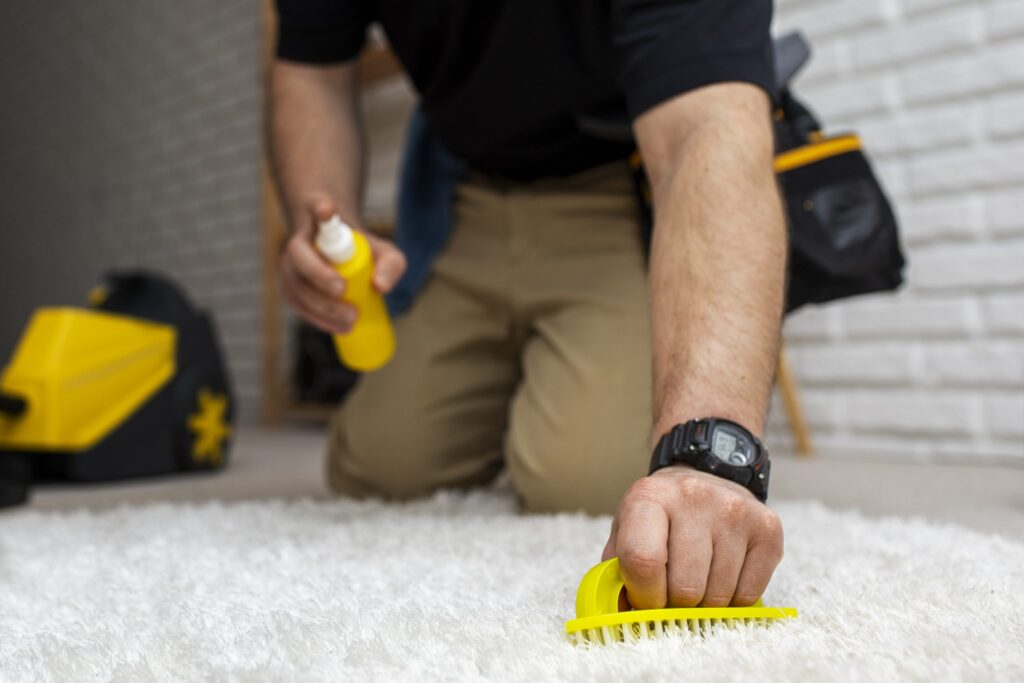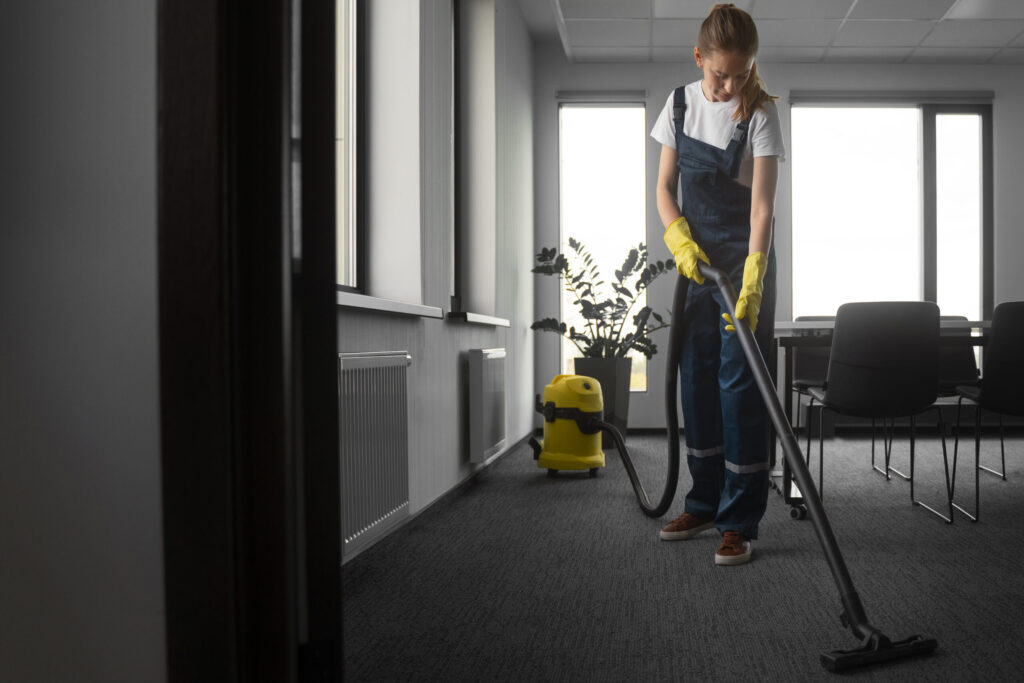If you’re like most people, your area rug gets a quick vacuum whenever you remember… and that’s about it. But here’s the catch: even if your rug looks clean, it’s often hiding dust, allergens, dander, and dirt that build up faster than you’d expect. That’s why understanding how often you should schedule area rug cleaning is more important than most homeowners realize.
Think of your rug as the quiet workhorse of your home. It absorbs everything—from muddy shoes to pet hair to everyday crumbs—yet rarely gets the deep care it needs. And if you live in a busy city or a place with lots of foot traffic, your rug might be collecting even more unseen debris without you knowing it.
In this guide, we’re breaking down exactly how often you should clean your area rug, what affects your cleaning schedule, and when it’s better to call in professional help. By the end, you’ll know how to keep your rug looking fresh, lasting longer, and creating a healthier space for your family. Whether you’re maintaining a treasured handwoven piece or just want your living room to feel cleaner every day, you’ll walk away with clear, practical insights you can actually use.
How Often Should You Clean Your Area Rug? General Rule of Thumb

So, how often should you actually clean your area rug? The truth is, there isn’t a one-size-fits-all answer—but there are simple guidelines you can follow. Most rugs benefit from routine upkeep plus a deeper clean at set intervals to protect the fibers, colors, and overall lifespan. Think of area rug cleaning as part of regular home maintenance, not something you only worry about when a stain appears.
Daily and Weekly Maintenance
For everyday care, a little consistency goes a long way. Light vacuuming once or twice a week removes surface dirt before it settles deeper into the fibers. That alone can dramatically extend the life of your rug. And if you’ve got a spill, don’t wait—spot clean it right away using a gentle blotting method. The faster you act, the less likely the stain will set.
High-traffic rooms like living rooms, hallways, and entryways might need a quick vacuum even more often. Meanwhile, rugs in quieter spaces (like bedrooms or home offices) can go a bit longer between passes.
Deep Cleaning Frequency Based on Rug Type
Different rugs have different needs. Materials, pile height, and construction all play a role in how often you should schedule a deeper clean.
Wool rugs: Naturally durable and stain-resistant, but they hold onto dust. Aim for a professional deep clean every 12–18 months.
Synthetic rugs: These tend to hide dirt well but accumulate oils from shoes and skin. A deep clean every 9–12 months is ideal.
Shag rugs: With their long fibers, they trap debris quickly. These benefit from more frequent attention—every 6–9 months.
Natural fiber rugs (like jute or sisal): Because they’re sensitive to moisture, they require careful handling and periodic dry cleaning methods.
Oriental and Persian rugs: These delicate, often handwoven pieces deserve professional care once a year to preserve their colors and craftsmanship.
Understanding your rug’s material helps you stay ahead of wear and tear—and saves you from costly restoration work later.
Lifestyle Factors That Change the Cleaning Schedule
Your home’s lifestyle has just as much influence on cleaning frequency as the rug itself. Here are a few things that may nudge you toward more frequent deep cleaning:
Pets: Fur, dander, and the occasional accident all settle deep in the rug. Pet-friendly homes benefit from cleaning every 6–12 months.
Kids: Spills, crumbs, craft supplies—need we say more? If you’ve got little ones, regular upkeep becomes even more essential.
Allergies: Rugs act like air filters, trapping allergens. If someone in your home is sensitive, more frequent area rug cleaning in Chicago can help improve air quality.
City living: Homes in busier areas tend to collect more dust and pollutants. For instance, households in the Chicago metro area often schedule cleaning more regularly because urban dust and winter salt make carpets dirtier, faster.
Keeping your lifestyle in mind makes it easier to find the sweet spot between “not enough” and “overdoing it”—ensuring your rug stays clean, fresh, and long-lasting.
What Affects Your Rug’s Cleaning Frequency? 7 Major Factors

Even though general guidelines are helpful, the real key to knowing how often you need area rug cleaning is understanding what’s happening in your home. Rugs don’t all get dirty at the same pace, and several everyday factors can speed up or slow down how often you should clean them. Here are the biggest things to pay attention to:
Foot Traffic Levels
This one’s straightforward—the more footsteps your rug sees, the faster it gets dirty. Rugs in living rooms, hallways, and entryways naturally collect more debris than rugs in low-traffic areas like spare bedrooms. If you start noticing dark, worn-looking paths forming across the rug, that’s a major sign your cleaning schedule needs to ramp up.
Rug Material & Construction
Some fibers hold up beautifully to daily wear… others are more high-maintenance.
Thicker piles trap dirt faster.
Dense weaves hide debris you may not see.
Delicate fibers, like silk or vintage wool blends, require more careful handling and benefit from professional care.
This is where expert help really matters. Professional cleaners have the right tools to lift deep-set dirt without damaging sensitive fabrics—especially when you’re relying on experienced area rug carpet cleaners who know how different materials react to moisture and detergents.
Climate & Local Environment
Your environment plays a bigger role than you might think. Homes in humid regions deal with moisture that can cling to fibers, while dry, dusty areas lead to more airborne particles settling into your rug. And if you’re in a city with heavy foot traffic and pollution—like Chicago—you’re more likely to notice frequent buildup, making consistent area rug cleaning even more important.
Pets & Children
Pets and kids are lovable and fun… but they definitely keep your rugs on their toes. Pet fur, crumbs, sticky fingers, muddy paws, and the occasional accident all contribute to faster dirt accumulation. If you have a busy household, you’ll probably need to clean your rugs more often than someone living alone or in a low-activity home.
Home Air Quality
Even the air inside your home impacts your rug. Dust, dander, and airborne debris eventually settle down into the fibers. If you notice that you’re dusting your furniture often, chances are your rug is collecting just as much—if not more. Routine cleaning helps keep your indoor air feeling fresher and reduces hidden buildup.
Color & Pattern
Believe it or not, color influences how often you should clean.
Light-colored rugs show dirt faster, so they need more frequent attention.
Dark or patterned designs tend to hide stains and dust, making it easier to put off cleaning longer—but the dirt is still there.
Using these factors to guide your cleaning schedule helps you stay ahead of wear and tear, making your rug look better and last much longer. It also ensures you’re not waiting too long before giving your rug the care it actually needs.
DIY vs. Professional Cleaning — Which One Do You Really Need?

When it comes to taking care of your rug, you have two main approaches: doing the cleaning yourself or bringing in a professional service. Both can be incredibly effective—but they serve different purposes. Knowing when to tackle maintenance at home and when to call in expert help can make a huge difference in how long your rug lasts and how fresh it looks.
What You Can Handle at Home (Safely)
Everyday rug care is surprisingly simple, and most of it you can absolutely handle on your own. Regular vacuuming is the biggest one. Keeping up with it prevents dirt from settling deep into the fibers, which makes every future cleaning easier. Just remember to be gentle with delicate or handwoven rugs and skip attachments that might tug at the fabric.
Spot-cleaning small spills is another thing you can confidently do at home. A clean cloth, a mild cleaner, and a little patience usually go a long way. The goal is to blot, not scrub, so you lift the stain without forcing it deeper. If your rug is on the lighter side and easy to move, even shaking it out outside helps remove trapped dust that your vacuum might miss.
Simple habits like rotating your rug every few months also make a difference. It keeps wear patterns even and helps preserve the rug’s color and texture over time. These at-home methods are great for maintenance and help bridge the gap between deeper cleanings.
What Only Professionals Can Do
No matter how diligent you are with home care, there are things DIY methods just can’t accomplish. Dirt works its way down into the base of the rug over time, and regular vacuums don’t have the power to pull it out. That’s where experienced cleaners with specialized equipment step in. Professional area rug cleaning goes far beyond surface-level results.
Experts know how to safely clean materials like silk, handwoven wool, or antique pieces that need a softer touch. They’re also equipped to remove stubborn odors, pet accidents, and deep-set stains that home remedies simply can’t reach. Professional area rug carpet cleaners use techniques designed to lift dirt without damaging dyes or fibers, which is especially important if your rug has sentimental or monetary value.
How Often Should You Hire Pros?
A good rule of thumb is to schedule professional cleaning every 12 to 18 months, depending on your lifestyle and rug type. If your home has kids, pets, or heavy foot traffic, you might benefit from scheduling a deep clean a bit sooner. And if you live in a busy urban area—especially a city like Chicago where dust, salt, and pollution accumulate more quickly—booking reliable area rug cleaning services a little more frequently can make a noticeable difference.
Knowing when to handle things yourself and when it’s time to bring in the professionals keeps your rug in its best possible condition, and it saves you from unexpected repair or replacement costs later.
Also Read: The Truth About Carpet Cleaning Services: DIY vs. Hiring the Pros
Signs Your Rug Is Overdue for Cleaning
Even with regular upkeep, every rug eventually reaches a point where it needs more than a quick vacuum or a spot-clean. One of the easiest signs to notice is lingering odor. Rugs naturally trap smells from pets, food, and everyday life, and once those odors stick around, it’s usually time for a deeper area rug cleaning. Another red flag is when allergies start acting up more than usual. Dust and dander often settle deep in the fibers, and if symptoms flare even after tidying your home, your rug may be the culprit.
You might also see stains that keep reappearing, even after you’ve cleaned them. That’s a sign the residue has seeped below the surface. A crunchy or stiff texture is another hint that dirt and buildup have taken over. And if the fibers start shedding or looking worn, that’s your rug telling you to reach out to a professional to restore its look and feel.
Keep Your Rug Looking Its Best
In the end, keeping your rug clean comes down to understanding your home’s needs, your lifestyle, and how different materials respond to everyday wear. Regular maintenance paired with timely deep cleaning keeps your space healthier, fresher, and far more inviting. When your rug starts showing signs of buildup, or you simply want to protect its long-term quality, exploring professional area rug cleaning near me can make all the difference. Take the next step by learning more about expert care, comparing local services, or scheduling your first deep clean—your rug (and your home) will thank you.